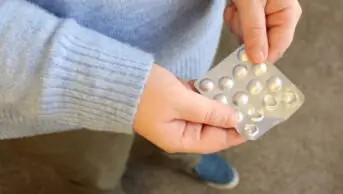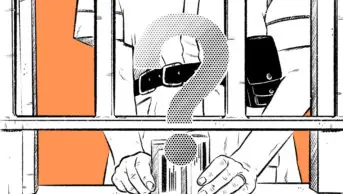
Shutterstock.com
Learning objectives
- Define delirium and its three subtypes, according to the level of arousal;
- Understand the risk factors associated with delirium and how it is diagnosed;
- Describe the non-pharmacological and pharmacological management of delirium.
Introduction
Delirium has been described as far back as the first century AD1. It is characterised by a rapid change in mental functioning, where there is a disturbance in attention, awareness and cognition2.
Delirium has previously been known as ‘acute confusional state’ or ‘acute confusion’; the move towards using the term ‘delirium’ is advocated by many to promote consistent communication and management strategies3. Delirium is often underdiagnosed and carries increased risk of adverse outcomes, including falls, functional decline, increased length of hospital stay and institutionalisation, as well as reduced quality of life4. Early recognition is vital because data suggest it could be prevented in up to one-third of older people5,6.
Systematic reviews that include data from Europe, the United States and several Asian countries suggest that community prevalence of delirium is around 1–2%, but may be as high as 14% in people aged over 85 years2,7. It is commonly seen in hospitalised patients with an overall prevalence of 23%, which increases to 50% in people aged over 65 years. In those adults residing in long-term care facilities, it is estimated that up to 16% of people are affected8,9. Delirium is also highly prevalent in people admitted to intensive care units and people referred to palliative care2,5; however, the management of these cohorts is outside the scope of this article.
This article will cover the definition and symptoms of delirium and its subtypes, how it is assessed and diagnosed, and its non-pharmacological and pharmacological management. Pharmacists in all settings should be aware of delirium because it is a serious condition that often signals an underlying illness or medication issue, which requires prompt intervention. Pharmacists also have a crucial role in prevention strategies and managing medicine-related risk.
Pathophysiology and risk factors
The pathophysiology of delirium is poorly understood and there is no single aetiology. The cause of delirium is usually multifactorial2,7,10. There are two sets of risk factors for delirium — predisposing and precipitating — and it is usually the interaction between these two factors that may lead to an increased risk of delirium, such as an older person with severe frailty who is given a relatively high dose of morphine (see Table 1)2,4,7,11. The National Institute for Health and Care Excellence (NICE) guideline on delirium recommends screening for delirium in people with any risk factors who present to hospital or who are in long-term care10.
In both the primary and secondary care setting, older people (aged 65 years or older) are more susceptible to delirium, as age and pre-existing cognitive impairment are important predisposing risk factors. It is also likely that this cohort of patients will have a greater number of other risk factors associated with delirium and so particular care needs to be taken. Depending on the type of risk factors identified, an individualised approach is needed to manage them. Steps to minimise risk may include: regular medication review; managing medical conditions (e.g. infections, electrolytes disturbances etc.) promptly; promoting sleep hygiene; ensuring hearing aids are working and eyesight tested regularly; encouraging mobility, where safe to do so; and adequate fluid intake to prevent dehydration and malnutrition2,4,7,11.
Presentation
The main features of delirium include:
- Acute onset — symptoms develop over a short period of hours or days. There is a sudden change from baseline;
- Fluctuating course — symptoms may fluctuate throughout the course of the day (often worsening at night) or even during a brief consultation. There may be periods of normal cognition combined with episodic confusion;
- Inattention — this can vary from very low level of attention to more subtle difficulties in maintaining focus, becoming easily distracted, or unable to follow simple instructions or conversations;
- Altered arousal — altered level of consciousness is a hallmark of delirium, which can be either heightened or reduced. There are three subtypes of delirium based on the level of arousal:
- Hyperactive — predominately signs include heightened arousal, restlessness, agitation, aggression;
- Hypoactive — predominately drowsy and inactive, which may present as reduced activity; reduced awareness of surroundings; reduced speech and/or speed of speech; and being withdrawn. This is the most common subtype, accounting for 50% of cases; however, it is often undiagnosed, particularly in older people. It can be mistaken for dementia or depression;
- Mixed — some people can present with a mixed picture with features of both hypoactive and hyperactive delirium. This subtype is hard to diagnose because it involves switching symptoms of both hyperactive and hypoactive delirium, sometimes over the course of the day.
- Other cognitive and perceptual changes — difficulties with memory, orientation or personality change. Up to one-third of people experience hallucinations (usually visual) or delusions, which can be very distressing for the patient and their families. People with delirium may be fearful and anxious2,3,7,10,12,13.
The quick onset of delirium and fluctuating course often distinguishes it from dementia and depression, where there is a more gradual onset over months and years. Table 2 highlights the differences between these conditions13. In most cases, delirium will resolve in a few days; however, in about 20% of cases, symptoms may persist for weeks and months, and some people may never return to their pre-delirium baseline2.
Diagnosis and assessment
Most people with delirium will require a hospital admission for urgent assessment, investigation and management of precipitating factors. Management in primary care may be appropriate if:
- The benefits of primary care management outweigh the risks of a hospital admission, and the person is clinically well to remain at home;
- The symptoms of delirium are not harmful to the person or others and can be managed safely in primary care;
- The delirium cause is known and treatable;
- A heathcare professional trained in delirium management is able to provide constant supervision;
- Follow-up can be organised3,10.
Delirium is a clinical diagnosis; a detailed history and clinical examination are much more helpful at making a diagnosis rather than a single test or combination of investigations. If the person affected is unable to provide a history, it is essential to gather information from family/caregivers. History should focus on onset and nature of change of behaviour, including a brief assessment of functional and cognitive state, if possible — by carrying out a cognitive screening test and finding out a social history, including how they usually manage at home — and a knowledge of previous cognitive function10.
It is also important to identify and manage any precipitating factors, as per Table 1. The DSM-5 criteria for delirium can be used to inform diagnosis, see Box.
Box: Definition of delirium
Delirium is defined by the Diagnostic and Statistical Manual of Mental Disorders, 5th edition (DSM-5) by the following criteria14:
A. Disturbance in attention (i.e. reduced ability to direct, focus, sustain and shift attention) and awareness (i.e. reduced orientation to the environment);
B. The disturbance develops over a short period of time (usually hours to a few days), represents an acute change from baseline attention and awareness, and tends to fluctuate in severity during a day;
C. An additional disturbance in cognition, such as memory deficit, disorientation, language, visuospatial ability or perception;
D. The disturbances in criteria A and C are not better explained by a pre-existing, established or evolving neurocognitive disorder and do not occur in the context of a severely reduced level of arousal, such as coma;
E. There is evidence from the history, physical examination or laboratory findings that the disturbance is a direct physiological consequence of another medical condition; substance intoxication or withdrawal (owing to a drug of abuse or to a medication); exposure to a toxin; or is owing to multiple aetiologies14.
A targeted physical examination looking for an obvious precipitant may include a full set of observations, especially screening for fever, hypoxia, hypo or hyperglycaemia or hypovolaemia3,7,10. Examining for a focus of infection, focal neurological deficits, seizures, constipation, acute retention of urine or the presence of medical devices, such as urinary catheters, can help identify the cause of delirium. Acute or poorly treated pain can also be a cause of delirium and a validated pain scoring tool can help when screening for this if there is co-existent cognitive impairment15.
Laboratory and radiological investigations may include a full blood count, C-reactive protein, urea and electrolytes, liver function tests, serum glucose, HbA1c, bone profile, thyroid function tests, vitamin B12, folate, blood and urine cultures, brain imaging and an EEG11. Other investigations, such as HIV and syphilis serology or lumbar puncture, may be rarely necessary, based on clinical probability. Other investigations may be determined by clinical history, including pelvic or chest X-rays and ECGs if clinical suspicion of pelvic fractures, pneumonia or acute myocardial infarction is suspected11.
Drug-related causes may be implicated in 39% of patients with delirium16. A medication review, screening for high-risk drugs such as benzodiazepines, opioids, other psychotropic drugs and anticholinergic drugs — including over-the-counter medications, such as chlorphenamine, diphenhydramine, promethazine and hyoscine — should be undertaken to determine their propensity to contribute to delirium3,10. Newly-started medicines, dose changes or drug withdrawal can all cause delirium17,18. Use of tools, such as the anticholinergic burden calculator, are important because drugs with anticholinergic activity are known to increase the risk of delirium, falls and other adverse outcomes in older people. This is related to age-related decline in neurological reserve and drug elimination with increased sensitivity to adverse drug effects19.
Tools to aid assessment
There are more than 50 tools developed to identify suspected delirium2,3. Episodic tools are useful for screening for delirium in the emergency department or at medical admission, around the time of surgery (particularly post-operatively) or at other times when a patient is exhibiting symptoms of delirium. Examples include the ‘4AT’, which comprises a battery of tests including Alertness, Abbreviated Mental Test-4, Attention and Acute Change or fluctuating course, and the ‘Confusion Assessment Method’ (CAM)3,10. Monitoring tools are used in secondary care to detect new onset delirium after hospital admission, including the ‘National Early Warning Score – 2’ (NEWS2) and the ‘Single Question in Delirium’ (SQiD: ‘Is this patient more drowsy or confused than usual?’)3,10.
If a monitoring tool gives a score suggestive of delirium, an episodic tool like the 4AT should be used to assess for delirium. Episodic tools are used to inform the DSM-5 criteria; the recommended clinical assessment tool for supporting a diagnosis of delirium is the 4AT3,10. If screening suggests delirium, a healthcare professional with expertise in diagnosis and management of delirium should make the final diagnosis.
If doubt exists as to whether the presentation is related to underlying dementia, this should be treated as delirium in the acute setting10. A collateral history using a structured validated tool such as the ‘Informant Questionnaire on Cognitive Decline in the Elderly’ (IQCODE) can be used to obtain a cognitive collateral history20. Use of tools such as the ‘THIS IS ME’ tool is helpful in patients with established dementia who have been admitted to hospital to aid early detection of delirium11. If a diagnosis of delirium is made, this should be clearly documented in the patient’s clinical records and appropriate information given to family or carers.
Management
There is no treatment for delirium, the focus of management is to identify and manage the underlying cause(s)10. Non-pharmacological methods should be employed first to re-orientate and reassure the patient, but if they exhibit severe distress or show symptoms that threaten their safety or the safety of others, pharmacological treatment may be required10. Good communication with the patient and their family or carers is a fundamental part of delirium management; for example, when talking to people with delirium, short and simple sentences should be used and information repeated (as necessary) so they are aware of what is happening and feel reassured. Keeping families/carers informed of the condition, its causes and potential management strategies can help to reduce fear and anxiety. Good communication can also foster collaboration between healthcare professionals and families, ensuring they can provide reassurance and a familiar presence to support the patient’s recovery.
Non-pharmacological options
There is strong evidence that multicomponent interventions can reduce the risk of delirium in hospitalised patients, which is considered the core of good practice2,10. Table 3 highlights interventions that should be incorporated into practice to support delirium management; these interventions can be employed to prevent delirium as well10,13. Most patients with delirium will be managed in hospital, but some of these interventions are relevant in the community setting. Some of the multicomponent interventions have also been shown to be effective in preventing falls21.
Pharmacological options
Pharmacological management is reserved for patients with severe agitation or psychosis, where the patient is a risk to themselves or others and where verbal and non-verbal de-escalation techniques have been ineffective10. There should be clear documentation in the patient’s record that non-pharmacological methods have been tried.
NICE recommend haloperidol as first-line treatment and this should be short term, usually up to one week, and the dose kept to a minimum19. The usual starting dose of oral haloperidol is 0.5mg to 1.0mg every two to four hours when required (with a maximum of 2.0mg in 24 hours) and the need for any ongoing treatment reviewed daily7,22. Good practice is to administer one or two doses and assess response, usually stopping the drug at that time.
The aim of treatment is to calm and not sedate the patient so the clinician can identify and manage the precipitating cause(s). If alcohol withdrawal is suspected, then the patient should be managed according to local alcohol withdrawal guidelines. The oral route is preferred; however, intramuscular injection may be required if the oral route is refused, or if the patient is too agitated10,22.
Haloperidol is contraindicated in the following cases:
- Parkinson’s disease;
- Lewy body dementia;
- Progressive supranuclear palsy (PSP);
- Multiple system atrophy (MSA);
- Known QTc interval prolongation and concomitant treatment with other drugs that can prolong the QT interval;
- Those with a history of seizures23,24.
Prior to starting treatment with haloperidol, an ECG is needed to assess the QTc interval, any electrolyte disturbances should be managed (as these can affect QTc prolongation) and any drugs currently prescribed that can prolong QTc interval should be reviewed23,24. Antipsychotics can cause neuroleptic malignant syndrome (NMS), a rare but potentially fatal adverse effect that may present with fever, increased sweating, rigidity, confusion, tachycardia, fluctuating consciousness and blood pressure, leucocytosis and raised liver function tests; and extrapyramidal symptoms, such as dystonia, akathisia and tardive dyskinesia, so it is important to monitor the patient closely24.
If there is a contraindication to haloperidol, benzodiazepine lorazepam can be considered (oral lorazepam is dosed at 0.5mg to 1.0mg every two to four hours when required (up to a maximum of 2.0mg in 24 hours)22. However, it is important to note that benzodiazepine use is associated with delirium prolongation, as well as increasing the risk of falls. It should not be used in those at risk of respiratory depression25.
In the context of dementia and delirium, risperidone is the only drug licensed for use in behavioural and psychological symptoms of dementia (BPSD). It is specifically indicated for the short-term treatment (up to six weeks) of persistent aggression in moderate-to-severe Alzheimer’s disease when non-pharmacological approaches have been unsuccessful and there is risk of harm to the patient and others26.
If delirium does not resolve within 72 hours, the diagnosis should be reassessed for underlying causes. Persistent delirium (lasting more than five days) is associated with poor outcomes and specialist geriatrician, or psychiatry input, may be warranted10,22.
Complications
People experiencing delirium are at increased risk of falls, incontinence and pressure ulcers, owing to impaired judgement and reduced mobility27. It can also lead to increased length of hospital stay, increased dependency and a risk of delayed recovery from the underlying illness. People who have had an episode of delirium are three times more likely to need institutional care within six months after discharge27.
Delirium is linked with an increased incidence of cognitive impairment, including dementia, with results from one study, published in 2022, showing that a first episode of delirium after the age of 65 years is associated with a 31% increase in risk of developing dementia within five years28. A prolonged delirium may uncover an undiagnosed cognitive impairment.
Data from the United States show there is a 25–33% hospital mortality rate associated with delirium29. This risk is still present post discharge: one study, results of which were published in 2022, showed that older people (aged 65 years and over) who experience delirium are up to 5.5 times more likely to die within 30 days compared with those without delirium; while another study showed one-year mortality rates of 41% for discharged patients following hospital admittance with delirium30,31.
Some people can recall their delirium experience, with the majority reporting significant distress, and fear and visual disturbances are most commonly described32. Distress can cause significant morbidity for patients and their families, with long-term psychological impact presenting as post-traumatic stress, anxiety and depression33. Early recognition of delirium, coupled with education and support for patients and their families, is essential to overcome this. A diagnosis of delirium should be coded in the patient record and, if an episode occurs in the hospital setting, this should be communicated to the GP at discharge.
Summary
Delirium is a complex and challenging condition to identify and manage. It is very common and is associated with significant morbidity and mortality. The majority of people with delirium will be managed in secondary care but it can present at any stage, so clinicians need to be aware of its features and risk factors.
Useful resources
Useful information can be found at the following:
- NHS information about the signs of delirium and when to access help;
- Dementia United, which provides patient information leaflets on how to recognise delirium and what to do about it;
- Health Education England’s ‘Delirium’ education resource, a booklet for people who have experienced delirium and for their carers;
- The Alzheimer’s Society’s resource on delirium and support line for patients and carers;
- Dementia UK’s information about delirium for patient and carers;
- The Royal College of Psychiatrists’ leaflet for anyone who has experienced delirium, knows someone with delirium or is looking after someone with delirium.
- 1.Adamis D, Treloar A, Martin FC, Macdonald AJD. A brief review of the history of delirium as a mental disorder. Hist Psychiatry. 2007;18(4):459-469. doi:10.1177/0957154×07076467
- 2.Wilson JE, Mart MF, Cunningham C, et al. Delirium. Nat Rev Dis Primers. 2020;6(1). doi:10.1038/s41572-020-00223-4
- 3.Risk reduction and management of delirium: a national clinical guideline. Scottish Intercollegiate Guidelines Network. 2019. Accessed February 2025. https://www.sign.ac.uk/media/1423/sign157.pdf
- 4.Raju K, Coombe-Jones M. An overview of delirium for the community and hospital clinician. Prog Neurol Psychiatry. 2015;19(6):23-27. doi:10.1002/pnp.406
- 5.Young J, Murthy L, Westby M, Akunne A, O’Mahony R. Diagnosis, prevention, and management of delirium: summary of NICE guidance. BMJ. 2010;341(jul28 2):c3704-c3704. doi:10.1136/bmj.c3704
- 6.Siddiqi N, House AO, Holmes JD. Occurrence and outcome of delirium in medical in-patients: a systematic literature review. Age and Ageing. 2006;35(4):350-364. doi:10.1093/ageing/afl005
- 7.Inouye SK, Westendorp RG, Saczynski JS. Delirium in elderly people. The Lancet. 2014;383(9920):911-922. doi:10.1016/s0140-6736(13)60688-1
- 8.Gibb K, Seeley A, Quinn T, et al. The consistent burden in published estimates of delirium occurrence in medical inpatients over four decades: a systematic review and meta-analysis study. Age and Ageing. 2020;49(3):352-360. doi:10.1093/ageing/afaa040
- 9.Young J, Meagher D, MacLullich A. Cognitive assessment of older people. BMJ. 2011;343(sep07 1):d5042-d5042. doi:10.1136/bmj.d5042
- 10.Delirium: prevention, diagnosis and management in hospital and long-term care. National Institute for Health and Care Excellence. 2023. Accessed January 2025. https://www.nice.org.uk/guidance/cg103
- 11.Kalish V, Gillham J, Unwin B. Delirium in older persons: evaluation and management. Am Fam Physician. 2014;90(3):150-158. https://www.ncbi.nlm.nih.gov/pubmed/25077720
- 12.Hosker C, Ward D. Hypoactive delirium. BMJ. Published online May 25, 2017:j2047. doi:10.1136/bmj.j2047
- 13.Delirium in Older People eLearning. British Geriatrics Society. 2023. Accessed January 2025. https://www.bgs.org.uk/topics/delirium
- 14.American Psychiatric Association. Diagnostic and Statistical Manual of Mental Disorders. Published online March 18, 2022. doi:10.1176/appi.books.9780890425787
- 15.Bo M, Porrino P, et al. The association of indwelling urinary catheter with delirium in hospitalized patients and nursing home residents: an explorative analysis from the “Delirium Day 2015.” Aging Clin Exp Res. 2018;31(3):411-420. doi:10.1007/s40520-018-0974-1
- 16.Catic AG. Identification and Management of In-Hospital Drug-Induced Delirium in Older Patients. Drugs & Aging. 2011;28(9):737-748. doi:10.2165/11592240-000000000-00000
- 17.Martin NJ, Stones MJ, Young JE, B dard M. Development of Delirium: A Prospective Cohort Study in a Community Hospital. International Psychogeriatrics. 2000;12(1):117-127. doi:10.1017/s1041610200006244
- 18.Alagiakrishnan K, Wiens CA. An approach to drug induced delirium in the elderly. Postgraduate Medical Journal. 2004;80(945):388-393. doi:10.1136/pgmj.2003.017236
- 19.Flacker J, Cummings V, Mach J, Bettin K, Kiely D, Wei J. The association of serum anticholinergic activity with delirium in elderly medical patients. Am J Geriatr Psychiatry. 1998;6(1):31-41. https://www.ncbi.nlm.nih.gov/pubmed/9469212
- 20.Jorm AF. A short form of the Informant Questionnaire on Cognitive Decline in the Elderly (IQCODE): development and cross-validation. Psychol Med. 1994;24(1):145-153. doi:10.1017/s003329170002691x
- 21.Goodwin VA, Abbott RA, Whear R, et al. Multiple component interventions for preventing falls and fall-related injuries among older people: systematic review and meta-analysis. BMC Geriatr. 2014;14(1). doi:10.1186/1471-2318-14-15
- 22.Healthcare Improvement Scotland in collaboration with the Scottish Delirium Association, NHS Education for Scotland and colleagues across NHS Scotland. Improving the care for older people: delirium toolkit. Healthcare Improvement Scotland. 2019. Accessed February 2025. https://ihub.scot/media/5955/20190312-delirium-toolkit-3-0-web.pdf
- 23.Haloperidol 1mg/ml Oral Solution Summary of Product Characteristics. Thame Laboratories. 2022. Accessed January 2025. https://www.medicines.org.uk/emc/product/10907/smpc#companyDetails
- 24.Joint Formulary Committee. Haloperidol. British National Formulary. 2024. Accessed January 2025. https://bnf.nice.org.uk/drugs/haloperidol/
- 25.Joint Formulary Committee. Lorazepam. British National Formulary . 2024. Accessed January 2025. https://bnf.nice.org.uk/drugs/lorazepam/
- 26.Joint Formulary Committee. Risperidone. British National Formulary . 2024. Accessed January 2025. https://bnf.nice.org.uk/drugs/risperidone/
- 27.Position statement 13: delirium in older people. Australian and New Zealand Society for Geriatric Medicine. 2012. Accessed January 2025. https://www.delirium.health.qut.edu.au/__data/assets/pdf_file/0007/858373/PositionStatementNo13_001.pdf
- 28.Leighton SP, Herron JW, Jackson E, Sheridan M, Deligianni F, Cavanagh J. Delirium and the risk of developing dementia: a cohort study of 12 949 patients. J Neurol Neurosurg Psychiatry. 2022;93(8):822-827. doi:10.1136/jnnp-2022-328903
- 29.Inouye SK, Rushing JT, Foreman MD, Palmer RM, Pompei P. Does delirium contribute to poor hospital outcomes? J Gen Intern Med. 1998;13(4):234-242. doi:10.1046/j.1525-1497.1998.00073.x
- 30.Anand A, Cheng M, Ibitoye T, Maclullich AMJ, Vardy ERLC. Positive scores on the 4AT delirium assessment tool at hospital admission are linked to mortality, length of stay and home time: two-centre study of 82,770 emergency admissions. Age and Ageing. 2022;51(3). doi:10.1093/ageing/afac051
- 31.McCusker J, Cole M, Abrahamowicz M, Primeau F, Belzile E. Delirium Predicts 12-Month Mortality. Arch Intern Med. 2002;162(4):457. doi:10.1001/archinte.162.4.457
- 32.Grover S, Ghosh A, Ghormode D. Experience in Delirium: Is It Distressing? JNP. 2015;27(2):139-146. doi:10.1176/appi.neuropsych.13110329
- 33.Partridge JS, Martin FC, Harari D, Dhesi JK. The delirium experience: what is the effect on patients, relatives and staff and what can be done to modify this? Int J Geriat Psychiatry. 2012;28(8):804-812. doi:10.1002/gps.3900


